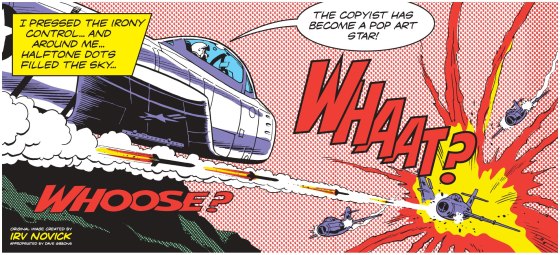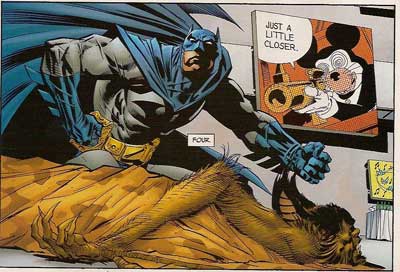
Dave Gibbon's WHAAAT (after Irv Novick)
From the moment my eyes were opened by the artwork of Jack Kirby, Steve Ditko, Wally Wood and others I have held a disdain for Roy Lichtenstein's work. It's not the paintings themselves that I take umbrage toward (if you'll allow me to use that word), but the acclaim that they receive while the original art he had used is largely ignored. For the record, Lichtenstein's art popularized comic book art back in the day, something that wily Stan Lee used to his advantage in the pop art era of Marvel Comics.
It's interesting to note that when Grant Morrison and Andy Kubert took over Batman, the first foray of fisticuffs was set in a pop art exhibit of paintings not unlike the pop comic art of Roy Lichtenstein!

Image from Batman #656
By and large, a comic book isn't even regarded as a work of art, at least without using the term 'graphic novel,' which is about as frustrating as Lichtenstein's imitations. Today comic books (at least the guys in tights variety) are fodder for Hollywood. But there is real magic to be found in comic books, especially those drawn by the 'Masters' that I cited above.
There's an interesting piece on Roy Lichtenstein over at Paul Gravett's site, which includes some back and forth on the validity of the artist's work with cartoonist and author Dave Gibbons (probably most famous for his work on the Watchmen with Alan Moore).

On February 24th 2013, Gibbons was invited back to be interviewed by Alastair Sooke who fronted an hour-long BBC4 documentary on Roy Lichtenstein. In what was largely a puff piece for the Tate Show with little questioning or controversy, the only interviewee to raise important issues was Dave Gibbons. Here are the highlights of Sooke's and Gibbons' discussion, centred around and standing in front of the 1963 canvas 'WHAAM!'. Sooke began by asking Gibbons about accusations that Lichtenstein was a plagiarist and referred to an article headline from the period, 'Pop Artists All Copycats'.
Dave Gibbons: "I would say 'copycat'. In music for instance, you can't just whistle somebody else's tune or perform somebody else's tune, no matter how badly, without somehow crediting and giving payment to the original artist. That's to say, this is 'WHAAM! by Roy Lichtenstein, after Irv Novick'."
--------
Sooke: "Be honest. Is there any part of you that is narked by the fact that I could buy this comic book for £5.95 and clearly, if this [painting] ever came up on the market, it would be worth tens and tens of millions of pounds."
Gibbons: "It doesn't nark me at all. I mean, this is worth, to me, far more than that."
Sooke: "What, for real? If you were offered this, you wouldn't have this? You'd take the Irv Novick original?"
Gibbons: "Absolutely."
It's revealing that Sooke is genuinely surprised that Gibbons values the comic book far higher than the painting. After all, so-called 'commercial art', like comic books, can often be poorly paid and done in part out of a love of the medium, whereas so-called 'fine art' can sell for millions, and so in many ways is surely far more 'commercial'. The art world is the art business and the real star-maker lurking in the wings was Leo Castelli, Lichtenstein's gallerist from the early Sixties, who saw his chance and lucked out with big-time with these paintings. Both men made the most of their opportunities.
The article is fascinating and well worth a read, including a wealth of material on the history of comic book art.


